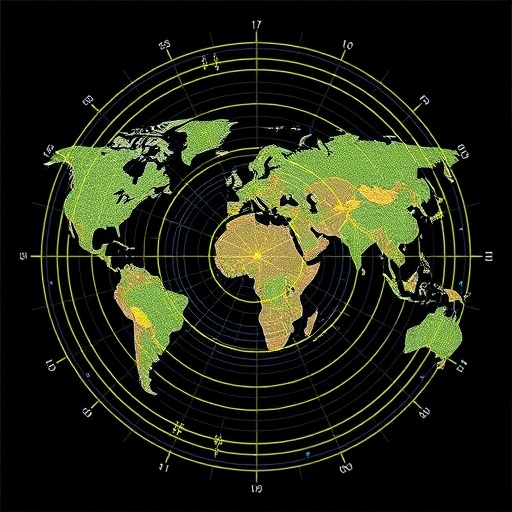In a groundbreaking advancement at the forefront of super-resolution microscopy, researchers have unveiled a novel technique that significantly expands the localization range of MINFLUX microscopy, promising to revolutionize single-molecule imaging. The new method, dubbed array detection-enabled MINFLUX, delivers unprecedented simplicity and robustness, addressing long-standing limitations in molecular localization distance without compromising accuracy.
MINFLUX microscopy has been celebrated for its exceptional ability to localize fluorescent molecules at nanometer precision, surpassing traditional optical diffraction barriers. However, a pivotal challenge remained: the typically narrow localization range hindered the method’s applicability to broader and more complex biological systems. The research team, led by Slenders, Patil, Held, and colleagues, has ingeniously integrated array detection to overcome this intrinsic spatial limitation, enabling a vastly extended operational range without sacrificing performance.
The innovation centers on replacing the point detector, conventionally used in MINFLUX setups, with a structured array detector equipped to capture spatial information more comprehensively. This shift allows for a more robust collection of fluorescence signals, which in turn improves the localization capability across a much larger volume. This approach not only simplifies the optical setup but also enhances resilience to system fluctuations and alignment issues, easing practical implementation.
.adsslot_C7LIK9O8wy{ width:728px !important; height:90px !important; }
@media (max-width:1199px) { .adsslot_C7LIK9O8wy{ width:468px !important; height:60px !important; } }
@media (max-width:767px) { .adsslot_C7LIK9O8wy{ width:320px !important; height:50px !important; } }
ADVERTISEMENT
At its core, MINFLUX leverages a tailored excitation pattern that maximizes photon efficiency by illuminating the sample with structured light configurations and thus achieves nanoscale precision in positioning. However, the standard method’s sensitivity to emitter position within the excitation field constrained its effective localization range. By employing an array detector, the researchers capture richer spatial emission profiles, effectively broadening the field within which accurate localization is possible.
Critical to this advancement is the sophisticated computational framework developed to interpret the multiplexed detector signals. Advanced algorithms decode the spatially resolved fluorescence patterns, reconstructing emitter positions with remarkable fidelity even when photons are sparse or background noise is significant. This computational synergy complements the hardware innovation, ensuring optimal data extraction from complex, dynamic samples.
Experimentally, the array detection MINFLUX system was rigorously characterized through a series of calibration and biological imaging experiments. The results demonstrated a consistent localization precision at the sub-10-nanometer scale throughout a localization volume significantly larger than previously achievable. This allows for tracking biomolecules in more physiologically relevant environments and over extended spatial ranges.
One of the transformational implications of this technology lies in cell biology and neuroscience, where observing molecular interactions and dynamics at exquisite resolution across larger cellular domains is essential. Rare molecular events and extended intracellular pathways, previously inaccessible due to spatial restrictions, can now be visualized with nanoscale accuracy, potentially unlocking new insights into cellular function and pathology.
Notably, the simplicity of the array detection approach paves the way for broader adoption of MINFLUX microscopy beyond specialized laboratories. The more forgiving optical alignment requirements combined with increased robustness reduce operational complexity and maintenance barriers, potentially democratizing high-resolution fluorescence imaging for a wider scientific community.
In the realm of fluorophore development and labeling strategies, the increased localization range accommodates diverse probe wavelengths and emission profiles, enhancing compatibility with various fluorescent tags. This flexibility may inspire novel labeling paradigms, facilitating multidimensional molecular mapping in complex biological specimens.
Beyond biological sciences, the expanded MINFLUX technique holds promise for nanotechnology and materials science, where precise localization of emitters such as quantum dots, nanoparticles, or defect centers within solid matrices is critical. The enhanced range enables mapping of nanostructures over extended fields, fostering advancements in device fabrication and characterization.
The research further underscores the importance of synergistic hardware-software integrations in modern optical microscopy. By coupling structured light excitation with array-based spatial detection and advanced computational algorithms, the system transcends previous limitations, embodying a new generation of intelligent microscopy that adapts and optimizes in real time.
From a practical perspective, the enhanced MINFLUX modality’s increased throughput and resilience to environmental perturbations facilitate long-term imaging campaigns critical for studying dynamic biological processes. Time-lapse and tracking experiments can be performed with greater reliability, opening avenues for observing molecular phenomena as they unfold naturally within living systems.
Moreover, the technique’s robustness extends to diverse sample conditions, including heterogeneous refractive index environments and moderate background fluorescence, which often challenge conventional super-resolution methodologies. This adaptability amplifies the usability of MINFLUX in complex and realistic biological contexts.
As the field anticipates next steps, ongoing efforts aim to miniaturize and integrate array detection components into compact, turnkey microscopy platforms. Such technological convergence would accelerate adoption across biomedical research, pharmaceutical development, and diagnostic imaging, solidifying MINFLUX as a mainstay in the microscopy arsenal.
The novel array detection MINFLUX system epitomizes a leap toward accessible, scalable, and high-precision localization microscopy. By unlocking larger spatial ranges without sacrificing simplicity or performance, it sets a new benchmark for imaging molecular processes with unparalleled clarity and breadth. The promise of this technology is vast, heralding a new era in nanoscopic imaging with profound implications across science and technology.
Subject of Research: Development of an array detection method to enhance the localization range of MINFLUX microscopy for improved robustness and simplicity in nanoscale molecular imaging.
Article Title: Array detection enables large localization range for simple and robust MINFLUX
Article References:
Slenders, E., Patil, S., Held, M.O. et al. Array detection enables large localization range for simple and robust MINFLUX. Light Sci Appl 14, 234 (2025). https://doi.org/10.1038/s41377-025-01883-1
Image Credits: AI Generated
DOI: https://doi.org/10.1038/s41377-025-01883-1
Tags: array detection in MINFLUX microscopybiological systems imaging techniquesexpanding localization range in microscopyfluorescence signal collection improvementsinnovative microscopy methodsmolecular localization distance challengesovercoming diffraction barriers in imagingpractical implementation of MINFLUXrobustness in optical microscopysingle-molecule imaging advancementsstructured array detector technologysuper-resolution imaging techniques





